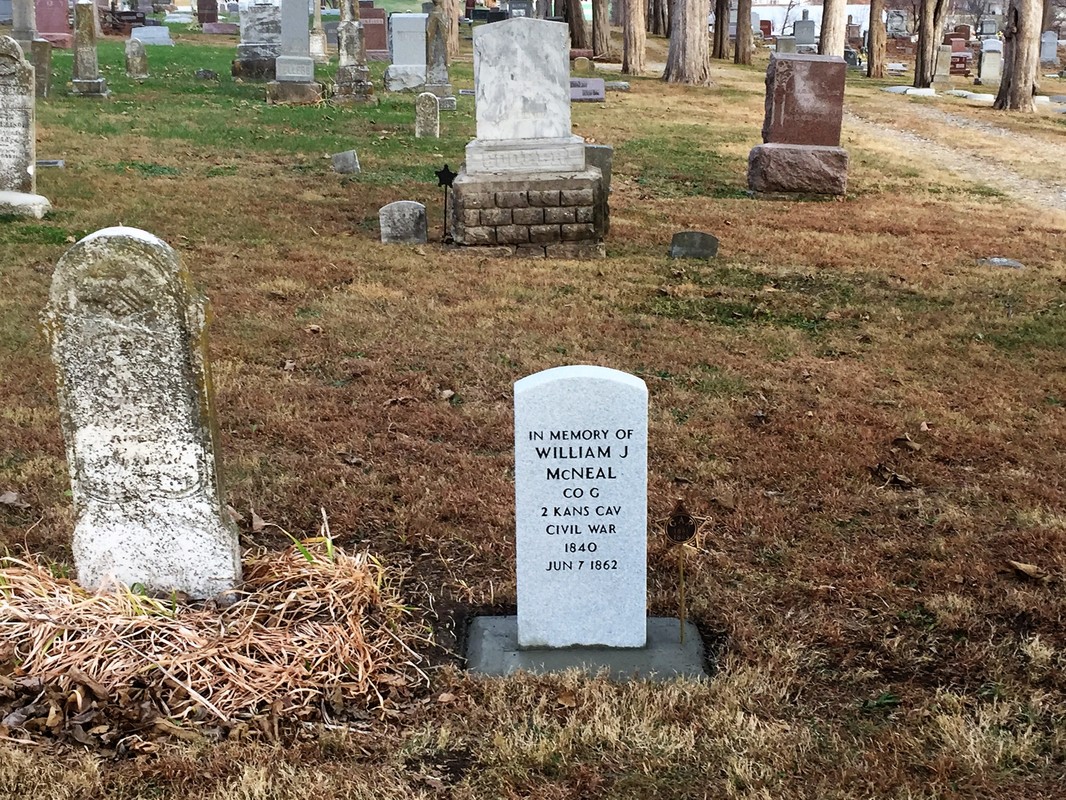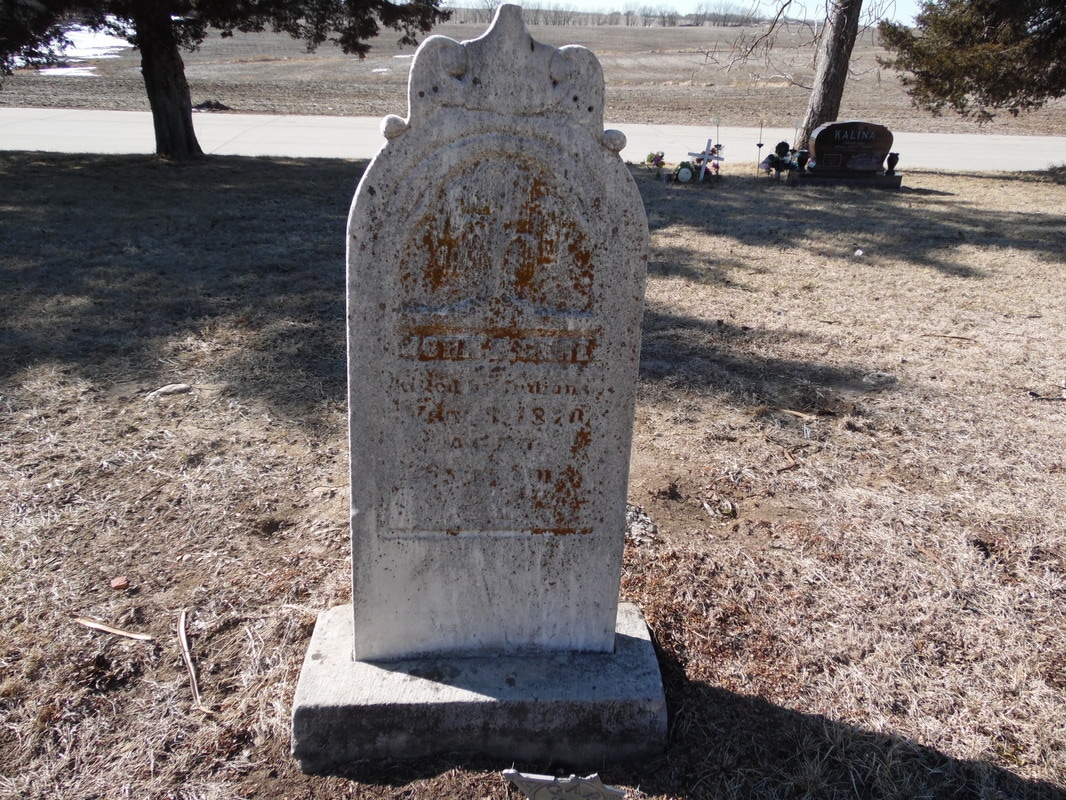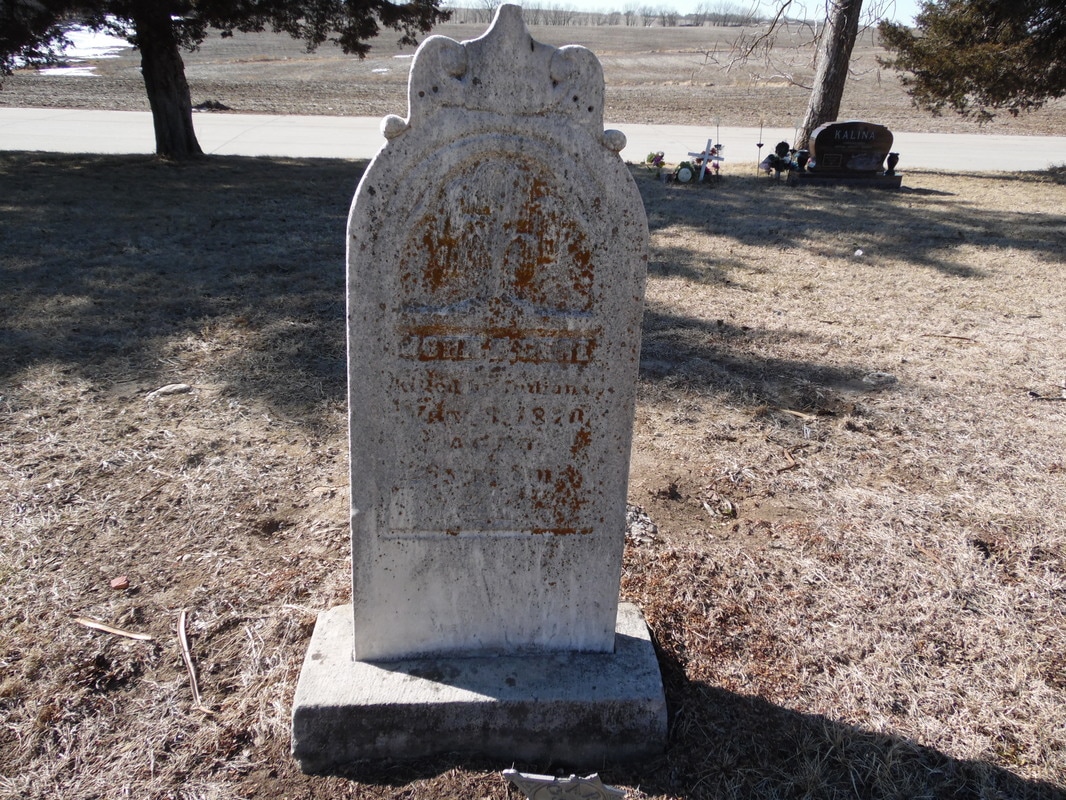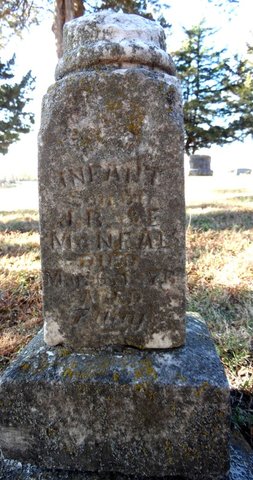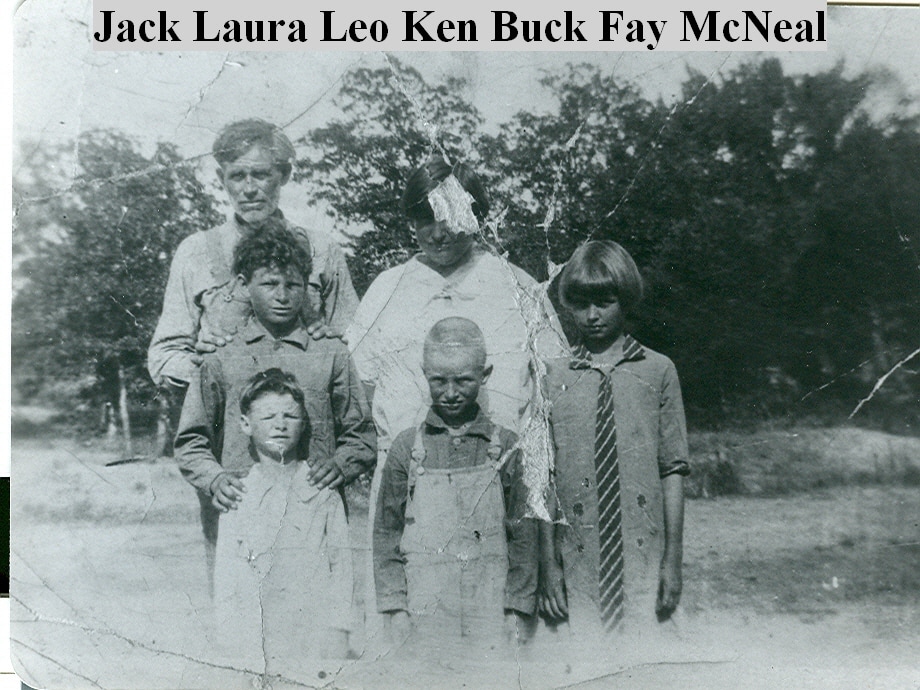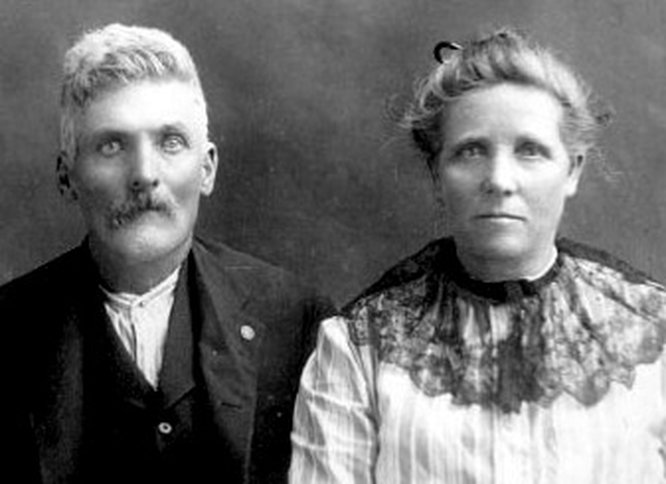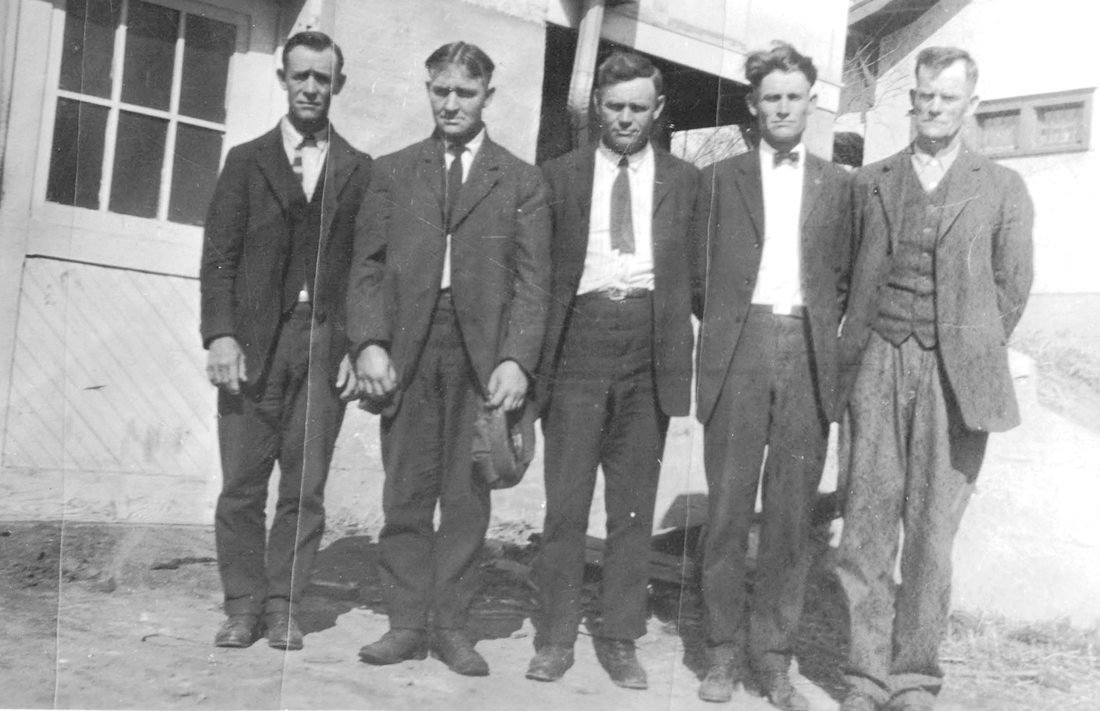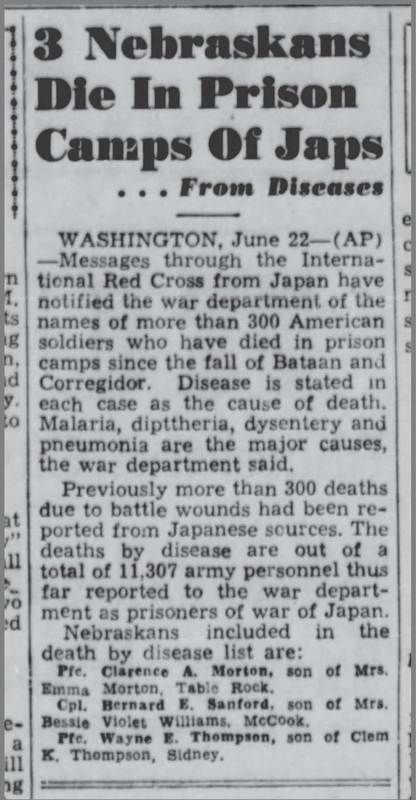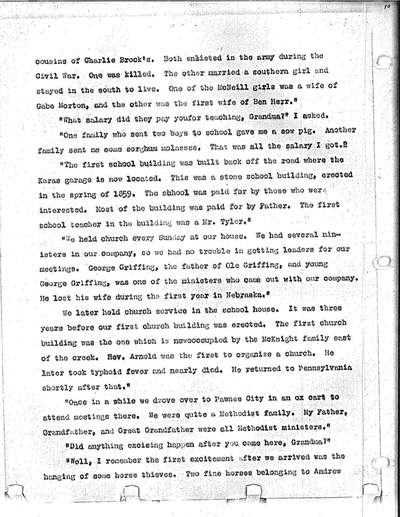william j. mcneal iii
worth remembering
the story of william mcneal
William J. McNeal III was born in 1840 in Buchanan County, Missouri. He was the oldest of seven. Following him, James was born in 1842, Rosetta in 1845, Andrew Jackson in 1846, Mary Ellen in 1851, Sarah in 1850, Martha in 1854, and Nancy in 1857.
We have no idea what name his mother called when she called him to supper or asked him to do something. Was he William or Will or Willie or Billy? This is often the case -- a tombstone may represent that the person there was named Gabriel Jackson Morton when in fact he was called Gabe. Annette may have been known as Annie, Mary Ellen as Ellen rather than Mary, Carolyn as Carrie. It is a sad loss to the personhood of those long gone.
In any event, the McNeals were pioneers. Buchanan County, Missouri, was barely settled in 1840. St. Joseph, the main city, was a baby. Founder Joseph Robidioux established a trading post in 1826, which in 1837 was joined to the State of Missouri in 1837. His trading post became the town of St. Joseph in 1843 and remained small until westward migration was accelerated by the 1848 discovery of gold in California. Settlers then streamed through St. Joe and across the river in Elwood, Kansas, the Pony Express riders took off on a relay run to California until the new railroad ran them out of business.
The McNeal family came to Table Rock in 1857. There was no railroad yet. They probably came up the Missouri River to the tiny river town of Aspinwall, and then came to Table Rock by wagon or walking. That was the usual course to Table Rock.
They were among the first-wave of settlers along the North Fork of the Big Nemaha River. Only about 25 people had come came between 1854 and 1856. In 1857 and 1858, the families of the Nebraska Settlement Company of Pennsylvania came pouring in. According to the president of the company, C. W. Giddings, there were 150 families. That included the McNeals.
William came to know young people in the other pioneer families of Table Rock. A number were his age. They included Jesse Morton and John Bousfield, who were his age. They included Julia Gere, who was also William's age, and Julia's brother John, who was two years younger. They also included Fannie and Lydia Giddings, the former being a year younger than William and Lydia three years young; they were two of the daughters of C. W. Giddings. The Mortons came in 1856, the Bousfields and McNeals in 1857, and the Giddings in 1858.
Fannie Giddings remembered when asked at age when 90, whether the young people had fun. "There were 20 boys and only six girls," she said, "“Why wouldn’t we have fun!” She said that the young people got together on Sundays, with the boys coming to the girls, and they did taffy pulls, parlor games, and so on. Fannie did not list the young people, but likely she counted William and James.
In late 1858, C.W. Giddings set up a school in his home. Fannie was the teacher. Asked about her school days, Fannie specifically cited William and James as her pupils. The families usually paid with goods. She received a sow from one family and some molasses from another. There was not much cash available. 1858 had been an extremely difficult year, with heavy rains that destroyed crops, and with much illness. Most of the settlers left Table Rock.
In 1860, William’s father – William McNeal, Jr. – died at the age of 67. He left little property – a little land some horses and wagons being the extent of anything significant.
William’s mother – Ellen– was 40 when her husband died and left her with four young daughters to raise. Nancy was a year old, Martha was 6, Mary was 9, and Rosetta was 15. William and James were grown, and the two other children, Andrew and Sarah, had passed away at some time before the 1860 census.
The War came. On November 28, 1861, William enlisted with the Company K of the 12th Kansas Infantry. He was 21. With him in Company G were three other Table Rock boys -- now men -- John N. Gere, John Bousfield, and Jesse Morton. (The 12th Kansas was soon re-designated as the 9th Kansas Infantry and then quickly the 2nd Kansas Cavalry.)
That the Table Rock men would join a Kansas unit may seem odd today, but in those days it was not unheard of. In the earliest days of the War, men committed to recruiting companies of locals. Recruitment sometimes ended when a company reached a certain number. The Nemaha County companies had numerous men and may have been full before the Table Rock boys could join. Another reason may be that Kansas may have been the nearest recruiting location. The men of William’s Company came from a couple of nearby Kansas counties including Marshall County, in which Summerfield, Kansas is located.
We have no idea what name his mother called when she called him to supper or asked him to do something. Was he William or Will or Willie or Billy? This is often the case -- a tombstone may represent that the person there was named Gabriel Jackson Morton when in fact he was called Gabe. Annette may have been known as Annie, Mary Ellen as Ellen rather than Mary, Carolyn as Carrie. It is a sad loss to the personhood of those long gone.
In any event, the McNeals were pioneers. Buchanan County, Missouri, was barely settled in 1840. St. Joseph, the main city, was a baby. Founder Joseph Robidioux established a trading post in 1826, which in 1837 was joined to the State of Missouri in 1837. His trading post became the town of St. Joseph in 1843 and remained small until westward migration was accelerated by the 1848 discovery of gold in California. Settlers then streamed through St. Joe and across the river in Elwood, Kansas, the Pony Express riders took off on a relay run to California until the new railroad ran them out of business.
The McNeal family came to Table Rock in 1857. There was no railroad yet. They probably came up the Missouri River to the tiny river town of Aspinwall, and then came to Table Rock by wagon or walking. That was the usual course to Table Rock.
They were among the first-wave of settlers along the North Fork of the Big Nemaha River. Only about 25 people had come came between 1854 and 1856. In 1857 and 1858, the families of the Nebraska Settlement Company of Pennsylvania came pouring in. According to the president of the company, C. W. Giddings, there were 150 families. That included the McNeals.
William came to know young people in the other pioneer families of Table Rock. A number were his age. They included Jesse Morton and John Bousfield, who were his age. They included Julia Gere, who was also William's age, and Julia's brother John, who was two years younger. They also included Fannie and Lydia Giddings, the former being a year younger than William and Lydia three years young; they were two of the daughters of C. W. Giddings. The Mortons came in 1856, the Bousfields and McNeals in 1857, and the Giddings in 1858.
Fannie Giddings remembered when asked at age when 90, whether the young people had fun. "There were 20 boys and only six girls," she said, "“Why wouldn’t we have fun!” She said that the young people got together on Sundays, with the boys coming to the girls, and they did taffy pulls, parlor games, and so on. Fannie did not list the young people, but likely she counted William and James.
In late 1858, C.W. Giddings set up a school in his home. Fannie was the teacher. Asked about her school days, Fannie specifically cited William and James as her pupils. The families usually paid with goods. She received a sow from one family and some molasses from another. There was not much cash available. 1858 had been an extremely difficult year, with heavy rains that destroyed crops, and with much illness. Most of the settlers left Table Rock.
In 1860, William’s father – William McNeal, Jr. – died at the age of 67. He left little property – a little land some horses and wagons being the extent of anything significant.
William’s mother – Ellen– was 40 when her husband died and left her with four young daughters to raise. Nancy was a year old, Martha was 6, Mary was 9, and Rosetta was 15. William and James were grown, and the two other children, Andrew and Sarah, had passed away at some time before the 1860 census.
The War came. On November 28, 1861, William enlisted with the Company K of the 12th Kansas Infantry. He was 21. With him in Company G were three other Table Rock boys -- now men -- John N. Gere, John Bousfield, and Jesse Morton. (The 12th Kansas was soon re-designated as the 9th Kansas Infantry and then quickly the 2nd Kansas Cavalry.)
That the Table Rock men would join a Kansas unit may seem odd today, but in those days it was not unheard of. In the earliest days of the War, men committed to recruiting companies of locals. Recruitment sometimes ended when a company reached a certain number. The Nemaha County companies had numerous men and may have been full before the Table Rock boys could join. Another reason may be that Kansas may have been the nearest recruiting location. The men of William’s Company came from a couple of nearby Kansas counties including Marshall County, in which Summerfield, Kansas is located.
On February 13, 1862, a newspaper in Brownville – the Brownville Advertiser – carried a letter from the Captain of Company K of the 9th Kansas, A.W. Mathews. William was in Company K. Titled “From Camp Hunter,” the letter addressed to “Friend Furnas,” the editor, was dated January 27, 1862. Camp Hunter was near what is now Baxter Spring, Kansas. The soldiers at Camp Hunter were taxed with fighting bushwhackers and Indians allied with the Confederacy. They protected wagon trains. And they minded the Cavalry’s horses, which grazed in the extensive grass there.
Among other things, Captain Mathews reported the arrival of a popular general, James H. Lane. General Lane was to take charge of an expedition to Missouri and Arkansas; the 12th Kansas was to be part of the expedition. “Since his arrival, the soldiers and citizens in this part of the country are all enthusiasm and all bound for Dixie. Jim is wonderfully popular. Even Captain Dixon put on his Sunday suit to meet him.”
William McNeal was probably not part of the soldiers who were “all enthusiasm.” In the next paragraph, Captain Mathews reported bad news. Measles had hit.
Measles was considered a dangerous disease during the Civil. It could proceed to a deadly form of pneumonia or even affect the brain. Two thirds of the 620,000 to 660,000 soldiers who died during the Civil War died of disease. In the Union Army alone, 67,000 soldiers came down with measles and 4,000 died of it, most of respiratory or cerebral complications.
In his January 1862 letter, Captain Mathews reported that 16 men in the Company were down with the measles. All were doing well: “except William McNeal of Table Rock, who has measles and pneumonia combined, and will probably not recover. The sick are all provided for as they would be at home.”
A measles epidemic had swept through William’s regiment. In a book by Roy Bird about the Civil War in Kansas, he said about it, “Early in 1862, some of the volunteers who enlisted in Kansas regiments bore terrible witness to the less than glorious side of soldiering during the Civil War.” The epidemic ran its course by March 1862.
Among other things, Captain Mathews reported the arrival of a popular general, James H. Lane. General Lane was to take charge of an expedition to Missouri and Arkansas; the 12th Kansas was to be part of the expedition. “Since his arrival, the soldiers and citizens in this part of the country are all enthusiasm and all bound for Dixie. Jim is wonderfully popular. Even Captain Dixon put on his Sunday suit to meet him.”
William McNeal was probably not part of the soldiers who were “all enthusiasm.” In the next paragraph, Captain Mathews reported bad news. Measles had hit.
Measles was considered a dangerous disease during the Civil. It could proceed to a deadly form of pneumonia or even affect the brain. Two thirds of the 620,000 to 660,000 soldiers who died during the Civil War died of disease. In the Union Army alone, 67,000 soldiers came down with measles and 4,000 died of it, most of respiratory or cerebral complications.
In his January 1862 letter, Captain Mathews reported that 16 men in the Company were down with the measles. All were doing well: “except William McNeal of Table Rock, who has measles and pneumonia combined, and will probably not recover. The sick are all provided for as they would be at home.”
A measles epidemic had swept through William’s regiment. In a book by Roy Bird about the Civil War in Kansas, he said about it, “Early in 1862, some of the volunteers who enlisted in Kansas regiments bore terrible witness to the less than glorious side of soldiering during the Civil War.” The epidemic ran its course by March 1862.
William did recover from measles and pneumonia. We do not know when or with what residual effects, only that he was able to rise and serve again as a soldier.
We know that William survived the measles because only a few months later he died a soldier. On June 7, 1862, he drowned at a river crossing near Ft. Riley, Kansas. His body was never recovered.
After the Civil War, an organization of Union veterans of the war formed called the Grand Army of the Republic. Among its other services, it provided ceremonial rites at the burial of veterans of the war. The ceremony ended with these words:
We know that William survived the measles because only a few months later he died a soldier. On June 7, 1862, he drowned at a river crossing near Ft. Riley, Kansas. His body was never recovered.
After the Civil War, an organization of Union veterans of the war formed called the Grand Army of the Republic. Among its other services, it provided ceremonial rites at the burial of veterans of the war. The ceremony ended with these words:
It seems well we should leave our comrade to rest in honor where over him will bend the arching sky, as it did in great love when he pitched his tent, or lay down, weary and footsore, by the way or on the battlefield for an hour's sleep….
Let us also then remember those honored dead who did not return to hearth and home, but lie in resting places known but to God.
William McNeal is one of those honored dead. He did not return to hearth and home but rather lies in a resting place known but to God.
Now for the first time, there is a place at which one may stand and think of William McNeal. The military has provided a tombstone in his memory and the cost of installation covered by a fund to which individuals have contributed and also Table Rock organizations including the Table Rock Community Club, the Table Rock Historical Society, and the Table Rock American Legion.
Memories of William’s very existence were lost at one point. The probate for his father was not closed until decades later. When an affidavit from the surviving children was required to close the probate, his younger sisters -- old people by then – were required to sign a probate document under oath within which all of their brothers and sisters, "living or dead," were listed. Three brothers were not on the list, James, William, and Andrew Jackson. There may have been good reason for that. When their father died in 1860, William and James were grown and off to war before the younger children could have known them well. Several family researchers have found him in the many years since then.
This forgotten soldier is worth remembering. He was flesh and blood. He was a six-year-old boy arriving with a family who were among the earliest pioneers of Table Rock. he was a boy who surely found time to play at times with friends his age like John Gere, John Bousfield, and Jesse Morton. He was a teenager who who wanted to learn enough to be taught at age 18 by a young teacher, Fannie Giddings, who was a year younger than he. He was a young man who lost his father at the age of 20. He was a man of 21 who went off to war and never returned.
With the help of the Table Rock Cemetery Association, William’s tombstone has been placed between the tombstone of his mother, Ellen McNeal Morton, and three infant nephews, the children of his brother James, who also served during the Civil War.
With the help of the Sons of Union Veterans of the Civil War, William McNeal’s tombstone is being dedicated on May 27, 2017.
Now for the first time, there is a place at which one may stand and think of William McNeal. The military has provided a tombstone in his memory and the cost of installation covered by a fund to which individuals have contributed and also Table Rock organizations including the Table Rock Community Club, the Table Rock Historical Society, and the Table Rock American Legion.
Memories of William’s very existence were lost at one point. The probate for his father was not closed until decades later. When an affidavit from the surviving children was required to close the probate, his younger sisters -- old people by then – were required to sign a probate document under oath within which all of their brothers and sisters, "living or dead," were listed. Three brothers were not on the list, James, William, and Andrew Jackson. There may have been good reason for that. When their father died in 1860, William and James were grown and off to war before the younger children could have known them well. Several family researchers have found him in the many years since then.
This forgotten soldier is worth remembering. He was flesh and blood. He was a six-year-old boy arriving with a family who were among the earliest pioneers of Table Rock. he was a boy who surely found time to play at times with friends his age like John Gere, John Bousfield, and Jesse Morton. He was a teenager who who wanted to learn enough to be taught at age 18 by a young teacher, Fannie Giddings, who was a year younger than he. He was a young man who lost his father at the age of 20. He was a man of 21 who went off to war and never returned.
With the help of the Table Rock Cemetery Association, William’s tombstone has been placed between the tombstone of his mother, Ellen McNeal Morton, and three infant nephews, the children of his brother James, who also served during the Civil War.
With the help of the Sons of Union Veterans of the Civil War, William McNeal’s tombstone is being dedicated on May 27, 2017.
what became of william's three friends with whom he enlisted?
John Bousfield. He came to Table Rock with is family in 1856 at the age of 16. In 1858, he left for Missouri then Kansas. By November 1861 he was back in Table Rock and enlisted in Company K of the 12th Kansas along with his friends William McNeal, John Gere, and Jesse Morton. All were identified in military records as being from Table Rock, various anecdotal accounts about Bousfield to the contrary. Bousfield stayed in the service until his unit was mustered out in 1864.
Bousfield came back to Table Rock, where in 1867 he married Esther Heywood, the daughter of Asa Heywood and Frances Mumford, both from first-wave pioneer families. John and Esther Bousfeld’s marriage license was the 76th issued in Pawnee County.
Bousfield moved to Nemaha County after the war, where he spent most of the rest of his life. The 1882 Andreas book “The History of Nebraska,” contains many biographies including his, and describes Bousfield as “a genial, friendly man of the strictest integrity, a Republican in politics and a man who has prospered in the world as a dealer in live stock.”
Bousfield is buried in Walnut Grove Cemetery in Brownville.
Bousfield came back to Table Rock, where in 1867 he married Esther Heywood, the daughter of Asa Heywood and Frances Mumford, both from first-wave pioneer families. John and Esther Bousfeld’s marriage license was the 76th issued in Pawnee County.
Bousfield moved to Nemaha County after the war, where he spent most of the rest of his life. The 1882 Andreas book “The History of Nebraska,” contains many biographies including his, and describes Bousfield as “a genial, friendly man of the strictest integrity, a Republican in politics and a man who has prospered in the world as a dealer in live stock.”
Bousfield is buried in Walnut Grove Cemetery in Brownville.
|
John Gere. As a teenager, John came to Table Rock with his family in 1857. After returning from the War, he married Lydia Giddings, the sister of his teacher Fannie Giddings and daughter of C.W. Giddings. They had two children.
In 1870, John left his pregnant wife to join a small group of men who were preparing a cluster of homesteads in Kansas. Gere and others were killed by a renegade band of Indians, but two escaped. John is buried in the Table Rock Cemetery, with a well-known tombstone bearing the epitaph, “Killed by Indians" at the top of which are the words, "Beloved Husband." Jesse Morton. Jesse was the same age as the others, born in 1840. Jesse’s family was in Table Rock by 1856. Different information is recounted in his biograph in the 1882 Andreas History of Nebraska. The Andreas book said that the family had been in Kansas since 1855, Jesse's mother died of consumption a year later, leaving six children between the ages of one and twenty five, and seven years later Jesse's father took the family out of Kansas. However, the Morton family was in Table Rock for the 1860 census, and the Andreas account makes a cryptic reference to the family "returning" to Table Rock from Kansas. It seems that they went to Kansas at some time in 1856 but had returned by 1860. After the war, Jesse married Louisa Holbert. At some point, according to the 1870 federal census, Jesse and Louisa lived with the extended Holbert family in Washington County Kansas (south of Fairbury, Nebraska). In the household were two small children who may have been theirs, Charles and A. J., both born in Nebraska, the former in about 1863 the latter in 1867; no record can be found of either after this census. Perhaps they did not live past childhood. Louisa died but we don’t know when, where, or why. Perhaps after her death Jesse returned to Table Rock. Here, he joined the local G.A.R. post when it was founded in about 1883. He was still in Table Rock at the time the 1890 Veterans Schedule was prepared. In 1901, late in life, Jesse married again. He married Marthena Shew, the widow of Daniel Shew, who had died in 1897. She died a month later. He lived with her sister’s family for a while. By at least 1910, he was in the old soldiers’ home in Leavenworth, Kansas where he died in 1916. He is buried in the cemetery connected to that place, the Leavenworth National Cemetery. |
interesting facts
about the mcneal family
|
A McNeal family page was prepared before this biography focused on William the son. Some of the information is duplicative but the information varies.
|
WILLIAM'S PARENTS
- William McNeal the father was born in Rochester, New Hampshire, in about 1793. His father had come to America in about 1733. There are no burial records for him with the Table Rock Cemetery Association, but their burial records were based on a walk-through many many years after the first burials in 1857. It is known that there are unmarked graves for which there are no records in the present day. Perhaps they were marked by wooden crosses or other material that did not stand the test of time.
- William may be buried near his wife. A number of McNeal family members are buried in the Table Rock Cemetery, in the southwest corner of the northeast quarter of the cemetery. There lie his wife Ellen and three infants of his son James, and his daughter Rosetta and her husband Hiram Billings. There are unmarked plots between the stones of Ellen and Rosetta. Perhaps these include William the father’s grave.
- Ellen Pearson McNeal, William’s mother, was born in Kentucky, in the year 1820. She died in 1879 at the age of 59 and is buried in the Table Rock Cemetery.
- Ellen’s tombstone gives her name as Ellen. She also went by Elendor and Eleanor. The variations of her name may be accounted for by the fact that she was illiterate. In a probate affidavit, which she signed with an X, she stated her name was Elendor, but that she also went by Ellen and Eleanor.
- Ellen was considerably younger than her husband William. When he died at age 67, she was only 40.
- Ellen married again. Her second husband was Joseph Bradford Morton, whose wife Nancy had died in 1854 or 1855, leaving him with six children between the ages of one and twenty five. Kansas – like Nebraska – opened for settlement in 1854, and Joseph had taken his family there. Within a year, Nancy had died of consumption. Joseph stayed in Kansas another seven years and then brought his family to Table Rock, in 1861. Joseph Morton’s son Jesse was one of the three other men who enlisted with William McNeal III. All four were the same age.
william's brothers and sisters
- William’s brother James R. McNeal was two years younger. He also enlisted, serving in the 13th Kansas Infantry. After the War, James married Elizabeth P. J. Taylor (1849-1926). Fannie Giddings Noris recalled that James met his wife while in the South and they settled in that place. (Elizabeth was from Arkansas.) However, James and Elizabeth lived in Table Rock for a substantial amount of time. They had three infants – born between 1867 and 1881 – who are buried in Table Rock, their graves marked by a single stone with a name om each side: James A., 1867, 2 weeks old; an unnamed infant, 1876 (7 days old); and infant Willie, 1881 (4 months old). While in Table Rock, James belonged to the local G.A.R. post. He eventually moved to Arkansas. He died in Eglantine, Arkansas in 1900. Elizabeth died in Bennington, Oklahoma in 1926. James & Elizabeth also had other children, including a son Andrew Jackson, born in Nebraska in 1872. Andrew Jackson went by the name of Buck. He died in Conway, Oklahoma in 1937.
the tombstone of three children of james r. and elizabeth mcneal (three sides)
This tombstone is in the Table Rock Cemetery on the south side of William's tombstone.
|
William’s sister Mary Ellen was eight years younger than him. In August 1868, she married William John (or John William) McGuiness. Her husband was a widower, with a daughter named Samantha born in June 1868,, and a son Joseph in 1872. Perhaps they divorced, because William McGuiness lived until 1919. She married George Hunt in 1875. He appears to have been a widower with a daughter Ella. Mary and George had at least five children between 1876 and 1888. George died in 1911 and Mary in 1928. She is buried in the Oakwood Cemetery at Weeping Water, Nebraska. (Thank you to the “hjohnson919” Ancestry tree for what appears to be well-researched information.)
- William’s sister Sarah was 10 years younger than William, and apparently died at some time before 1860. She was not with the family on that census, even though she would have only been ten years old.
|
martha and family
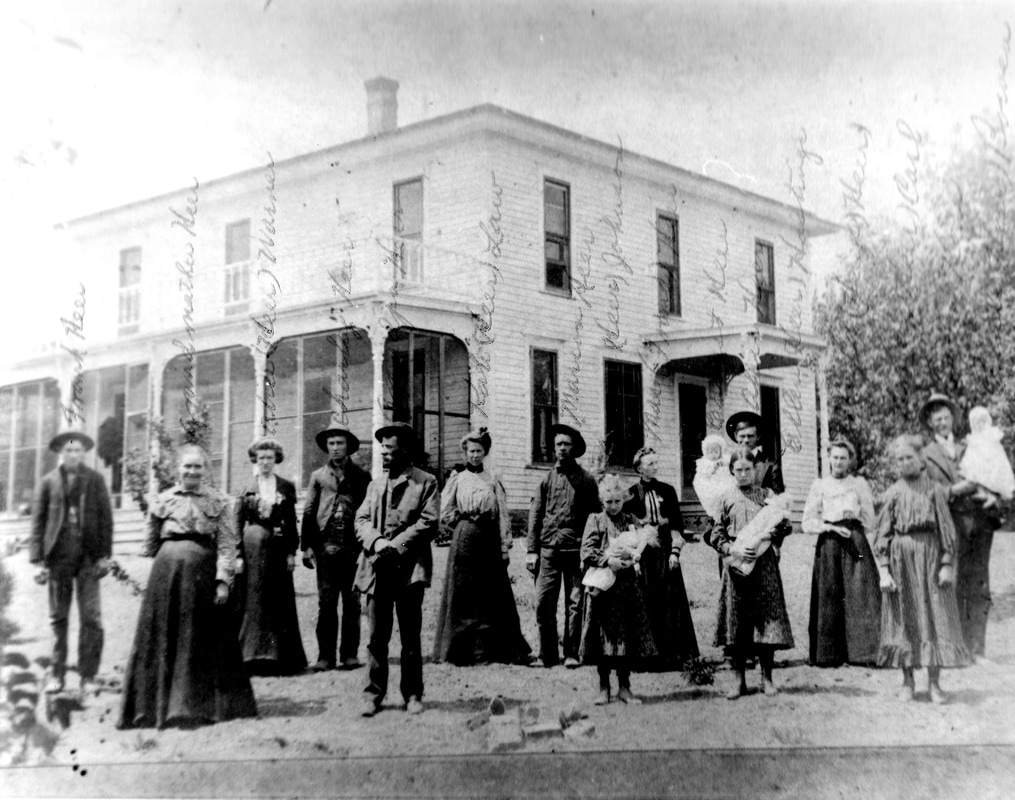
Photo 673, Martha and Ben Heer, taken in the Fall of 1902. Martha McNeal Heer is second from the left and her husband Ben is next to her. Names are written in above each person. Frank Heer, Grandmother Heer, Alice Heer Warner, Charles Heer, Grandpa Heer, Kate Heer Law, Marion Heer, (the little girl: (Annie?) Heer Johnson; Mae _surname here_____ Heer, baby Ernest Heer held by A_____ Heer, girl holding doll is Ellen Heer (Hastings?), Ma___(Martha) H___ Heer, ____ Heer Carl, _______ Heer, and baby (Pearl) Heer Bowen.
William’s sister Nancy. Nancy was the youngest, born in 1857. She was the only one of the children who was born in Nebraska. In 1878, Nancy married Gabriel (Gabe) Morton. He was 27 and she was 21. Gabe was a step brother, one of the children of Joseph Morton, her mother's second husband. Gabe was reputed to be the best fiddle player around and was well-respected. Nancy and Gabe had eight children. At least two stayed in Table Rock, Roy Morton (who died in 1982) and Joseph B. Morton (who died in 1955).
descendants OF WILLIAM'S
BROTHERS & SISTERS
William was not married and there are no known direct descendants. We know of the following descendants of his siblings.
Descendants of William’s brother James R. McNeal
Jack McNeal’s father Andrew Jackson McNeal was one of the children of William’s brother James.
Descendants of William’s sister Mary McNeal Hunt
Carol Mundt is the great granddaughter of William’s sister Mary, who became the wife of George Hunt. Mary is buried in Oakwood Cemetery in Weeping Water, Nebraska.
Descendants of William’s sister Martha McNeal Heer
Chris Heer of Tacoma, Washington. William was a brother of Chris’s great grandmother Martha McNeal, by way Martha and Ben’s son Charles, who was Chris’s grandfather. and Charles’ son Frank, Chris’s father.
Note that Martha’s husband Ben Heer was a widower and when she married him he had two children by his first wife, Katie and John. Those two children were half-siblings of Martha and Ben’s children. The descendants above are from her children with her first husband. A number of local people are descended from Martha and Ben Heer, including the Bowen family.
Descendants of William’s sister Nancy McNeal Morton
Leroy Malmos of Nebraska and sister Linda Morton Kern and Dr. Wayne Morton of Missouri and his sister Dr. Elaine Morton Bohlmeyer of Oregon are grandchildren of Joseph B. Morton. Joseph B. Morton's mother Nancy McNeal Morton was William’s sister.
Descendants of William’s brother James R. McNeal
Jack McNeal’s father Andrew Jackson McNeal was one of the children of William’s brother James.
Descendants of William’s sister Mary McNeal Hunt
Carol Mundt is the great granddaughter of William’s sister Mary, who became the wife of George Hunt. Mary is buried in Oakwood Cemetery in Weeping Water, Nebraska.
Descendants of William’s sister Martha McNeal Heer
Chris Heer of Tacoma, Washington. William was a brother of Chris’s great grandmother Martha McNeal, by way Martha and Ben’s son Charles, who was Chris’s grandfather. and Charles’ son Frank, Chris’s father.
Note that Martha’s husband Ben Heer was a widower and when she married him he had two children by his first wife, Katie and John. Those two children were half-siblings of Martha and Ben’s children. The descendants above are from her children with her first husband. A number of local people are descended from Martha and Ben Heer, including the Bowen family.
Descendants of William’s sister Nancy McNeal Morton
Leroy Malmos of Nebraska and sister Linda Morton Kern and Dr. Wayne Morton of Missouri and his sister Dr. Elaine Morton Bohlmeyer of Oregon are grandchildren of Joseph B. Morton. Joseph B. Morton's mother Nancy McNeal Morton was William’s sister.
william's grand-nephew clarence morton
|
This bio was compiled by Sharla Sitzman of the Table Rock Historical Society. Thank you to descendants Chris Heer and Jack McNeal. for some of this information. Thank you also to the VanTassel-Derryberry and hjohnson919 family trees on Ancestry.
some sources of information
unofficial burial records of the table rock cemetery association
Click on the document. The first four pages are maps of each quarter of the cemetery. Names, etc., follow.
Your browser does not support viewing this document. Click here to download the document.
military information
|
February 13, 1862, page 2
|
recollection of fannie giddings norris at about age 90
Click to enlarge these excerpts.
